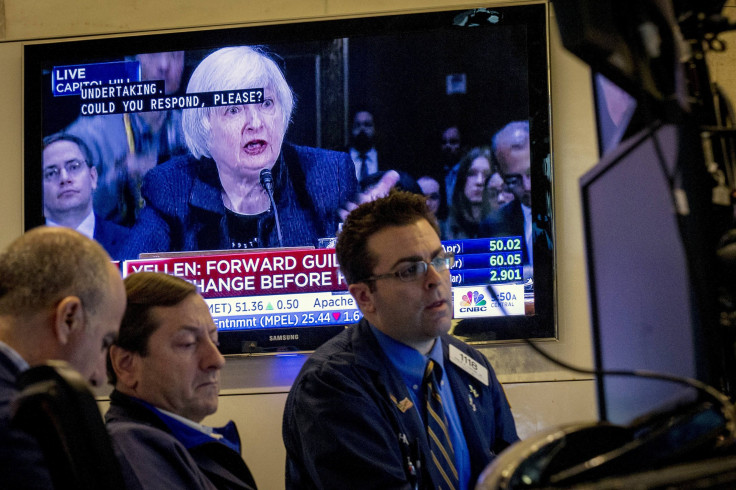Dow Jones Industrial Average Gains 120 Points As Federal Reserve Remains On Track To Raise Rates In September

U.S. stocks closed higher for the second straight session, with the Dow Jones Industrial Average gaining more than 100 points, as the Federal Reserve kept rates unchanged. Policymakers said the economy is “expanding moderately,” signaling the central bank remains on course to lift interest rates as early as September -- for the first time in nearly a decade .
All 10 Standard & Poor's 500 sectors closed higher, led by a more than 1 percent gain in energy and industrials.
The Dow Jones Industrial Average (INDEXDJX:.DJI) rallied 121.12 points, or 0.69 percent, to close at 17,751.39. The S&P 500 index (INDEXSP:.INX) added 15.32 points, or 0.73 percent, to finish at 2,108.57. And the Nasdaq composite (INDEXNASDAQ:.IXIC) edged up 22.53 points, or 0.44 percent, to end at 5,111.73.
The Federal Open Market Committee (FOMC), a board of governors at the Federal Reserve that determines the direction of monetary policy, did specifically not indicate when an increase in the federal funds rate is coming this year. A notable omission from the statement was any reference to Greece’s debt crisis, or to slower growth and the recent big stock market declines in China, indicating the central bank does not view either as major threats to the U.S. economy.
“Today's more upbeat statement, particularly as it relates to the labor market, could be a sign that the FOMC is more likely to move in September than December. But unless conditions deteriorate in the next few months, a rate hike is coming this year,” Stuart Hoffman, chief economist at PNC Financial Services Group, said in a research note Wednesday.
Hoffman forecasts the central bank’s first rate increase will likely be announced at the Fed’s next meeting on Sept. 16-17 meeting.
Dow component Microsoft Corporation (NASDAQ:MSFT) led the index higher, gaining 2 percent, while DuPont Co. (NYSE:DD) experienced the biggest decline, down nearly 1 percent.
Shares of Twitter Inc. (NYSE:TWTR) dropped more than 14 percent Wednesday, falling to a 52-week low of $31.06, a day after the social media company posted earnings that beat Wall Street forecasts, but it warned of slow user growth.
Investors are turning their attention to Facebook Inc. (NASDAQ:FB), which reported results after the closing bell Wednesday. The social media giant beat Wall Street forecasts on earnings and revenue, but shares still fell 3 percent in after-hours trading to as low as $91.85. Facebook’s mobile daily average users were 844 million, an increase of 29 percent from a year ago, but slightly down from the previous quarter. Facebook's mobile daily average users were 798 million in the first quarter, up 31 percent from the same period a year earlier.
Shares of Facebook have gained nearly 30 percent in the last 12 months.
Economists will get a glimpse into the overall health of the U.S. economy Thursday when the Commerce Department releases its first estimate of GDP.
U.S. gross domestic product, the broadest measure of goods and services produced across the economy, is forecast to grow at a seasonally adjusted annual rate of 2.6 percent in the second quarter, according to analysts polled by Thomson Reuters.
The U.S. economy shrank 0.2 in the first three months of 2015, driven by a slowdown in shipping due to labor disputes at West Coast ports.
Market professionals are also looking ahead to Thursday’s economic calendar, with weekly jobless claims -- the number of Americans filing new claims for unemployment -- due out at 8:30 a.m. EDT. U.S. jobless claims tumbled to a nearly 42-year low last week as fewer Americans filed new applications for unemployment benefits.
Initial claims for state unemployment benefits declined 26,000 to a seasonally adjusted 255,000 for the week ended July 18, the lowest level since November 1973, the U.S. Labor Department said last week.
Economists forecast that jobless claims last week rose by 15,000 to 270,000 for the week ending July 25, according to analysts polled by Thomson Reuters.
© Copyright IBTimes 2024. All rights reserved.












